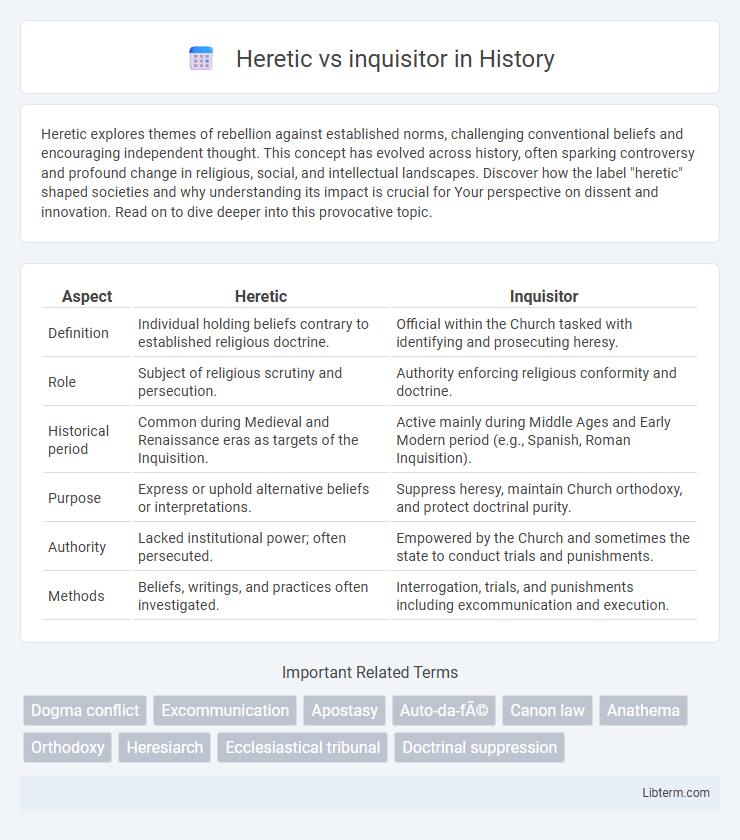Heretic explores themes of rebellion against established norms, challenging conventional beliefs and encouraging independent thought. This concept has evolved across history, often sparking controversy and profound change in religious, social, and intellectual landscapes. Discover how the label "heretic" shaped societies and why understanding its impact is crucial for Your perspective on dissent and innovation. Read on to dive deeper into this provocative topic.
Table of Comparison
| Aspect | Heretic | Inquisitor |
|---|---|---|
| Definition | Individual holding beliefs contrary to established religious doctrine. | Official within the Church tasked with identifying and prosecuting heresy. |
| Role | Subject of religious scrutiny and persecution. | Authority enforcing religious conformity and doctrine. |
| Historical period | Common during Medieval and Renaissance eras as targets of the Inquisition. | Active mainly during Middle Ages and Early Modern period (e.g., Spanish, Roman Inquisition). |
| Purpose | Express or uphold alternative beliefs or interpretations. | Suppress heresy, maintain Church orthodoxy, and protect doctrinal purity. |
| Authority | Lacked institutional power; often persecuted. | Empowered by the Church and sometimes the state to conduct trials and punishments. |
| Methods | Beliefs, writings, and practices often investigated. | Interrogation, trials, and punishments including excommunication and execution. |
Defining Heretic and Inquisitor: Core Concepts
A heretic is an individual who holds beliefs or doctrines that deviate from established religious orthodoxy, often challenging the authority of the dominant faith. An inquisitor is an official appointed by religious institutions to investigate, interrogate, and prosecute heretics to maintain doctrinal purity. The core concept of a heretic revolves around dissent from accepted dogma, while the inquisitor embodies enforcement and suppression of heresy.
Historical Origins of Heresy and Inquisition
The historical origins of heresy trace back to early Christian communities where divergent beliefs challenged orthodox doctrines, prompting the Church to define and defend its theological boundaries. The Inquisition emerged in the 12th century as an institutional mechanism to identify, investigate, and punish heretics, solidifying ecclesiastical authority over doctrinal purity. Heretics represented individuals or groups whose beliefs opposed established Church teachings, while inquisitors were appointed officials tasked with enforcing orthodoxy through interrogation, trial, and sanction.
Major Motives: Why Inquisitors Target Heretics
Inquisitors target heretics primarily to maintain religious orthodoxy and suppress beliefs deemed heretical that threaten the established doctrine. Their major motive revolves around preserving institutional power by eliminating dissent that could destabilize the religious hierarchy. Protecting the social order and ensuring conformity within the faith are key drivers behind inquisitorial actions against heretics.
Power Dynamics: Authority vs. Dissent
The power dynamics between Heretic and Inquisitor center on the clash of authority versus dissent, where the Inquisitor wields institutional power to enforce orthodoxy and suppress deviation. Heretics challenge this dominance by embodying dissenting beliefs that threaten established order, often facing severe consequences for their defiance. This struggle highlights a fundamental conflict between control maintained through dogmatic enforcement and resistance fueled by ideological rebellion.
Methods of Inquisition: Trials and Interrogations
Inquisitors employed rigorous methods of inquisition including formal trials and intense interrogations designed to uncover heresy through confessions or evidence. These trials often featured legal procedures such as witness testimonies, examination of heretical texts, and the use of psychological and physical pressure to extract information. Heretics faced these methods under strict ecclesiastical jurisdiction, where inquisitorial techniques combined legal and religious authority to maintain doctrinal conformity.
Famous Heretics and Notorious Inquisitors
Famous heretics such as Giordano Bruno, known for advocating heliocentrism and challenging Catholic doctrines, faced persecution leading to execution by the Inquisition. Notorious inquisitors like Tomas de Torquemada wielded immense power during the Spanish Inquisition, aggressively suppressing heresy with torture and executions. The clash between dissenting thinkers and zealous inquisitors shaped religious and intellectual history, highlighting the harsh consequences of doctrinal dissent.
Societal Impact: Fear, Control, and Resistance
Heretics challenged established religious doctrines, provoking fear among authorities intent on preserving social order through inquisitors who wielded judicial power to enforce orthodoxy. The inquisitor's role institutionalized control by prosecuting dissenters, which instilled widespread societal fear and compliance but also sparked clandestine resistance movements opposing oppressive religious persecution. This dynamic significantly shaped medieval and early modern societies, influencing political structures, cultural expression, and the development of legal frameworks around heresy and belief.
Religious Doctrine vs. Independent Thought
Heretics challenge established religious doctrines by promoting independent thought and questioning orthodox beliefs, often leading to accusations of blasphemy and heresy. Inquisitors defend doctrinal purity through rigorous investigation and enforcement of orthodoxy, aiming to suppress dissent and maintain religious authority. This dynamic embodies the conflict between institutional control and individual interpretation within faith communities.
Transformation Over Time: Inquisition in Modern Perspective
The transformation of the inquisition from medieval religious tribunals to modern institutions reflects a shift from punitive heresy hunts to judicial processes emphasizing human rights and due process. Contemporary inquisitors function as legal professionals or investigators who prioritize evidence-based inquiries over confessions extracted under duress. This evolution highlights the broader societal move from dogmatic enforcement to critical scrutiny and accountability in addressing dissent and ideological deviations.
Heretic and Inquisitor in Popular Culture
Heretics and inquisitors frequently appear in popular culture as symbolic opposites representing rebellion and authority, respectively. Heretics are often depicted as individuals challenging established beliefs or orthodox systems, embodying themes of dissent and persecution. In contrast, inquisitors are portrayed as enforcers of institutional power, tasked with rooting out heresy and maintaining doctrinal purity, frequently shown in literature, films, and games like "Warhammer 40,000" and historical dramas.
Heretic Infographic

 libterm.com
libterm.com